Force can be classified as internal or external forces. We will be discussing the types of the latter, one that is an external force.
The external force is exerted between the body and the surrounding. It occurs when the force is applied to any object from outside and is non-conservative. The change in velocity is the basic effect caused by external forces. The types of external forces are:
Friction force

When an object moves over a surface, then a restricting force emerges that tries to oppose the motion of the body. This force is known as the Force of Friction or Frictional Force. Some of the kinetic energy of the body is converted into heat energy to obstruct the motion and get lost. Hence frictional force is non-conservative.
The basic example of friction is the lightning of a matchstick. When we rub the stick on the surface, friction comes into play and converts kinetic energy into heat that ignites the matchstick. Friction also helps us to walk and write.
The friction force is dependent on the factors; normal force and a coefficient of friction µ.
The straightforward formula for friction is:
![]()
Where,
N is the normal force acting perpendicularly to the surface
µ is the coefficient of friction, and its value completely depends on the surface.
The frictional force can be classified into given four categories:
- Static Friction
- Sliding Friction
- Rolling Friction
- Fluid Friction
Normal Force

The normal force acts on every object perpendicularly to keep them from falling off and at a stable position. It only comes into the act when the body and surface are in contact with each other. For example, a book lying on a table experiences gravitational force downwards but does not fall. The normal force pulls upwards to keep it off from falling. It is generated by the surface of the object. Every object, even humans too, experiences the normal force, and it is a non-conservative force.
From the diagram we can see:
![]()
Where,
N is the normal force
m is the mass of the body
g is the acceleration due to gravity.
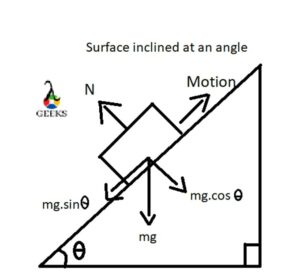
From the free-body diagram:
On splitting W into two components, we get:
![]()
Here,
N = normal force
m = mass
g = acceleration due to gravity
Θ = angle between the inclined surface
Air Resistance Force
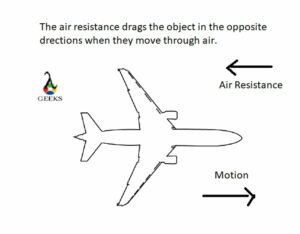
The external force caused by the body flying or moving through the air is known as air resistance force or air drag. It acts in the opposing direction of the motion of the object. The resistance is also caused due to the collision of air molecules and the object’s surface. Hence, this force depends on two factors; the velocity of the moving body and the area of the object. That is why all the aircraft and birds have a streamlined front to reduce the area, which leads to less air resistance force and hence their easy movement.
The force of air resistance is given as:
![]()
Here,
Fair = air resistance force
c = force constant
v = velocity of the object
The negative sign indicates that the direction of the force air resistance is opposite to the motion of the object.
Applied Force
The simple external push and pull force that is applied to the object is applied force. It tends to move the body at rest or change the velocity of the moving body. The applied force can be classified into contact and non-contact forces. The contact force is the type of external force. The applied force can be differentiated as:
- Pull: When the force is applied to move the object towards oneself. Example: Pulling the rope
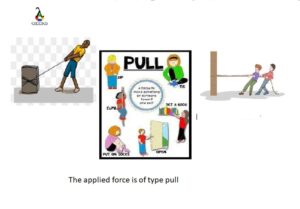
- Push: When the force is applied in such a way to move the object in the forward direction and away from oneself. Example: Pushing the box.
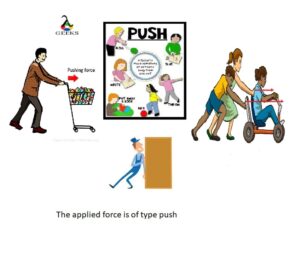
- Collision: when two bodies collide with each other, they both exert force on each other. The collision tends to change the velocity and direction of the collided bodies. The collision can be elastic and inelastic.
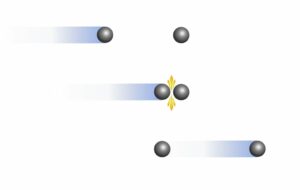
According to the second law of motion, the formula of applied force is:
![]()
Where,
F = applied force
m = mass of the body
a = acceleration produced.
Tension
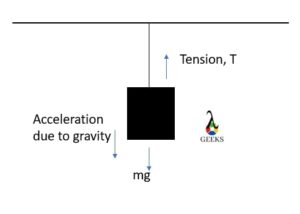
When a load is attached to any kind of string, cable, rope, or similar object, a pulling force is exerted along the length of the object in the upward direction. In physics, this force is known as tension. It is important to remember that tension does not apply on its own; it has to be provided to the system. While explaining the concept of tension force, we take the string to be massless so that the applied tension is equally transmitted to the whole string. Some of the examples of tension force are:
- Tug of war
- Towing of car
- Pulling a box with the help of a rope.
From the free diagram, the formula for tension can be determined as:
![]()
Where,
T= tension force
m=mass of the body
g= acceleration due to gravity
Types of Friction Force
Static Friction
Static friction comes into play when the body and the surface area are at the rest position with respect to each other. This force helps the object to avoid any trigger caused by applied forces. The object only comes into motion when the applied force exceeds the static force.
The basic example of static friction is pushing a heavy box. The static friction does not allow the motion of the box. It is only when two or three people come together and apply greater force than the static friction that the box moves.
Other examples are:
- Book on a table
- Clothes hanging on the rack
- A car parked on a hill
The value of static friction is calculated from the formula:
![]()
To move the object, the inequation is given as:

Here,
Fs is the static friction
µs is the coefficient of static friction
N is the normal force acting perpendicularly to the surface
Sliding friction
When an object slides over another body or surface, then the opposition that is created against the motion is known as the sliding friction.
An example of sliding friction is ice skating. When a person pushes the ice skate forward by applying their weight, sliding friction is created. It generates the heat energy that melts the ice and helps in sliding the skate easily.
More example of sliding friction is:
- Sliding book over the table
- Rubbing of rag on the counter
- Sliding through a slide
- Sliding car on the ramp
The formula for sliding friction is given as:
![]()
Here,
Fs = sliding friction
µs = coefficient of sliding friction
N = normal force
Rolling friction

The friction that acts on a body when it rolls over a surface is known as rolling friction or rolling drag. When an object rolls over a surface, both of them get deformed at the point of contact that tends to create motion below the surface.
It is due to the rolling friction that a rolling ball stops after some time. Without friction, the ball would keep rolling forever. Other examples of rolling friction are:
- The wheels of all the vehicles generate rolling friction
- Rolling of pencil
The formula for rolling friction is:
![]()
Where,
Fr is the rolling friction
µr is the coefficient of rolling friction
N is the normal force
Fluid friction
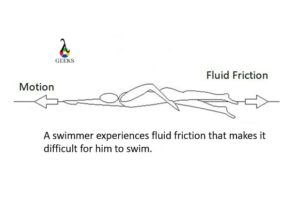
Friction not only opposes the movement of solid objects. The layers of liquid when slide against each other, friction is generated between them known as fluid friction. It also restricts the movement of other objects into the liquid.
The fluid friction restrains the movement of swimmers, and hence it requires much energy for swimming in water. Also, the water gushing around their body is due to fluid friction. The other examples of this friction are:
- Stirring of a spoon into coffee or milk
- Movement of the submarine through the water.
Frequently Asked Question (FAQs)
What is external force?
A body can experience a force in two ways externally and internally.
The force exerted from outside on any object is known to be an external force. It can be a contact force as well as a non-contact force. Mostly external force is contact force and comes into action when an object interacts with its surroundings. Pushing a table and car are some examples of external force.
Is external force conservative or non-conservative?
The conservation of energy classifies the force as conservative and non-conservative.
When an object experiences the external force, energy is generated, and work is done on it. In doing the work, some of the energy gets dissipated. Hence the total energy before and after the force is applied does not remain the same. Therefore, an external force is non-conservative.
What are the types of external force?
The external force is of the following five types:
- Friction
- Tension
- Normal force
- Air resistance
- An applied force.
What are the effects of external force?
The external force generally tends to change the velocity of the moving body.
What are the advantages of friction?
The opposing force acting on a moving object is called friction.
Friction is a necessary phenomenon that makes our everyday work easier. When we walk on the ground, the friction caused by the ground on our feet helps in walking by pushing us forward. It also helps us to write, in skiing and many other things.
How can friction be of disadvantage?
Friction makes our everyday work possible, but it also causes some damage.
The opposition generated on the moving body by friction is done by converting kinetic energy into heat energy. The heat causes unnecessary wear and tear of objects and also reduces the working efficiency of the machines. In order to subdue the friction, a lot of energy is required.
Hi,
I am Rabiya Khalid, I have completed my masters in Mathematics. Article writing is my passion and I have been professionally writing for more than a year now. Being a science student, I have a knack for reading and writing about science and everything related to it.
In my free time, I let out my creative side on a canvas.